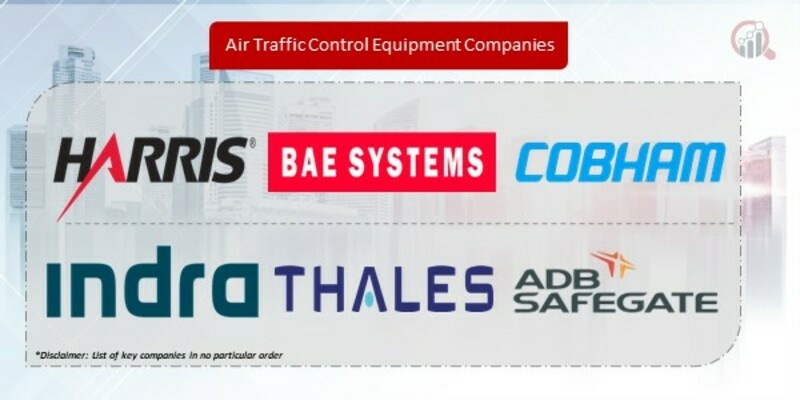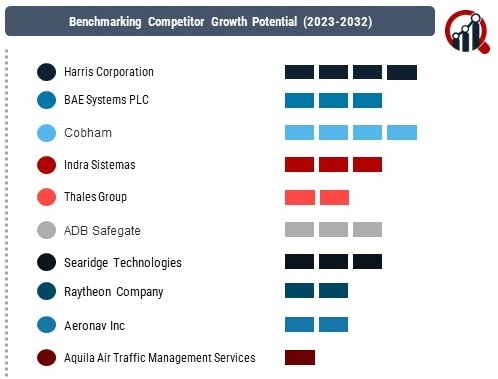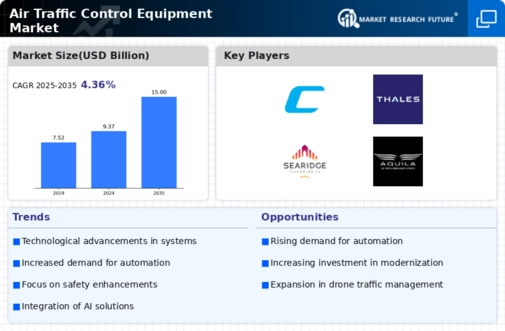Top Industry Leaders in the Air Traffic Control Equipment Market

Key Players
Harris Corporation (US)
BAE Systems PLC (UK)
Cobham (UK)
Indra Sistemas (Spain)
Thales Group (France)
ADB Safegate (US)
Searidge Technologies (Canada)
Raytheon Company (US)
Aeronav Inc (Canada)
Aquila Air Traffic Management Services (UK)
Strategies Adopted
To maintain a competitive edge, key players in the ATC equipment market employ diverse strategies to address the evolving needs of the aviation industry. Technological innovation stands out as a primary strategy, with companies investing heavily in the development of next-generation ATC systems. Thales Group, for example, has been a trailblazer in digital transformation, incorporating artificial intelligence and machine learning into their systems for enhanced decision-making and automation.
Collaboration and partnerships are also prevalent strategies, as companies seek to combine their strengths and expertise. Raytheon Technologies, through collaborations with aviation authorities and governments, enhances its global reach and contributes to the development of standardized ATC solutions. Additionally, a focus on research and development allows these key players to stay ahead of regulatory changes and technological advancements, ensuring their solutions meet the stringent safety and efficiency requirements of the aviation industry.
Factors for Market Share Analysis
Several factors contribute to the market share analysis within the ATC equipment sector. The capability to provide integrated and comprehensive solutions, covering communication, navigation, and surveillance, is a key determinant. Companies that offer end-to-end solutions, streamlining air traffic management processes, often secure a larger market share.
Furthermore, compliance with international standards and regulations, such as those set by the International Civil Aviation Organization (ICAO), is crucial. Key players invest in research and development to ensure their equipment not only meets current standards but is also adaptable to future regulatory changes. Reliability, scalability, and the ability to integrate seamlessly with existing infrastructure are additional factors influencing market share, as air traffic management systems need to function cohesively within a complex aviation ecosystem.
New and Emerging Companies
While key players dominate the market, the ATC equipment sector has seen the emergence of new and innovative companies bringing fresh perspectives and technologies. Adacel Technologies, Terma, and Frequentis are notable examples of companies making inroads into the market with specialized solutions and a focus on niche segments.
These emerging players often excel in addressing specific challenges, such as cybersecurity in ATC systems or the development of modular and scalable solutions. As the industry embraces digital transformation, these companies contribute to the diversification of the market, offering alternatives that cater to evolving demands and emerging trends in air traffic management.
Industry News Recent developments in the ATC equipment market underscore the industry's commitment to staying at the forefront of technological advancements. The integration of satellite-based navigation systems, like the Global Navigation Satellite System (GNSS), has become a focal point. Companies are investing in upgrading existing infrastructure to harness the benefits of GNSS, enhancing navigation accuracy and reliability.
Moreover, the adoption of automation, artificial intelligence, and machine learning in ATC systems has gained traction. These technologies are not only improving the efficiency of air traffic management but are also contributing to the development of predictive analytics for better decision-making. Industry collaborations and joint ventures continue to be a prevalent theme, with companies pooling resources to address the challenges of modernizing and harmonizing air traffic control globally.
Current Company Investment Trends
Investment trends in the ATC equipment market reflect a focus on innovation, cybersecurity, and sustainability. Companies are allocating resources to research and development to create more efficient and resilient systems. The implementation of cybersecurity measures is paramount, given the increasing threat landscape in the digital age. Key players are investing in advanced cybersecurity solutions to safeguard critical ATC infrastructure from potential threats.
Sustainability is also emerging as a key investment trend, with a growing emphasis on developing eco-friendly and energy-efficient ATC equipment. This includes the integration of renewable energy sources and the implementation of green technologies to reduce the environmental impact of air traffic control operations. Investors are increasingly recognizing the importance of companies that align with global efforts to create a more sustainable and resilient aviation industry.
Overall Competitive Scenario
The competitive landscape of the Air Traffic Control equipment market is marked by the influence of established players and the contributions of new entrants, all navigating towards innovative and sustainable solutions. Key players leverage strategies such as technological innovation, collaborations, and compliance with international standards to maintain their dominance. Factors influencing market share include the ability to offer integrated solutions, regulatory compliance, and adaptability to emerging trends.
The entry of new and emerging companies injects dynamism into the market, fostering diversity and specialization. Industry news highlights the ongoing transformation towards satellite-based navigation and the incorporation of advanced technologies for efficient air traffic management. Current investment trends underscore a commitment to innovation, cybersecurity, and sustainability, reflecting the industry's response to the challenges and opportunities in the ever-evolving airspace.
As the ATC equipment market continues to evolve, companies that can navigate these challenges, adapt to emerging technologies, and prioritize safety, efficiency, and sustainability will likely emerge as leaders in this competitive and critical sector of the aviation industry.
Recent DevelopmentTop of Form
Thales Group (France):
Contract wins: Thales secured a series of major contracts in recent months, solidifying its position as a leading player in the ATC equipment market. These include:
A €1.2 billion contract from the Polish Air Navigation Services Agency (PANSA) to modernize its entire ATC system.
A contract with the Egyptian Ministry of Civil Aviation to upgrade its ATC systems at Cairo and Alexandria airports.
A partnership with Frequentis to develop a next-generation digital tower solution for the Norwegian Air Traffic Control Service.
Focus on innovation: Thales is actively investing in research and development for next-generation ATC technologies, including artificial intelligence, automation, and advanced surveillance systems. The company recently unveiled its StarX system, which uses AI to optimize air traffic flow and improve airport efficiency.
L3Harris Technologies (USA):
Strategic acquisition: L3Harris acquired Rockwell Collins in 2020, significantly expanding its portfolio of ATC equipment and services. The combined company now offers a wide range of solutions, from radars and communication systems to software and training programs.
Global reach: L3Harris has a strong presence in the global ATC market, with customers in over 100 countries. The company recently secured a contract with the Indian Air Force to upgrade its ATC systems at several key airports.
Indra Sistemas (Spain):
Focus on Europe: Indra is a major player in the European ATC market, with a strong presence in Spain, Germany, and other countries. The company recently completed the implementation of its Advanced Runway Safety Improvement (ARSI) solution at Geneva Airport, which has significantly boosted safety and efficiency.
New technologies: Indra is actively developing new technologies for the ATC industry, including drone traffic management systems and cybersecurity solutions. The company recently partnered with AirMap to develop a platform for managing drone traffic in urban areas.
Other key players:
Raytheon Technologies (USA): Focuses on advanced radar systems and air traffic management software.
Saab AB (Sweden): Offers a range of ATC equipment and services, including radars, communication systems, and air traffic management software.
Northrop Grumman Corporation (USA): Develops advanced sensors and surveillance systems for ATC applications.
Emerging trends in the ATC industry:
Automation: Increased use of automation to improve efficiency and reduce controller workload.
Artificial intelligence: AI-powered systems for optimizing air traffic flow, predicting delays, and identifying potential safety hazards.
Cybersecurity: Increasing focus on protecting ATC systems from cyberattacks.
Drone traffic management: Development of new systems for managing the safe and efficient integration of drones into airspace.










